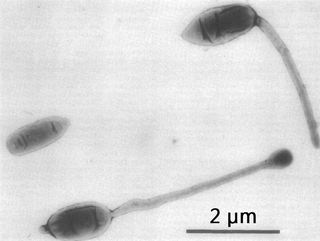The Desulfurellaceae are a small family of Campylobacterota, given their own order and class. The family was classified under Deltaproteobacteria per established nomenclature in LPSN, but phylogenetic evidence has moved it elsewhere.
The Halanaerobiales are an order of bacteria placed within the class Clostridia, and encompassing two families, the Halanaerobiaceae and the Halobacteroidaceae. Originally placed within the highly polyphyletic class Clostridia, according to the NCBI and LPSN, it is now thought to lie outside the Bacillota. Halanaerobiales are halophilic obligate anaerobes with a fermentative or homoacetogenic metabolism.
In taxonomy, Hyphomonas is a genus of the Hyphomonadaceae.
Dehalococcoidia is a class of Chloroflexota, a phylum of Bacteria. It is also known as the DHC group.

Hyphomicrobium is a genus of Gram-negative, non-spore-forming, rod-shaped bacteria from the family of Hyphomicrobiaceae. It has a large polar or sub-polar filiform prostheca very similar to that of Caulobacter. In addition to having a nutritional function, the prostheca also plays a role in the initiation of DNA replication.
Hyphomicrobium aestuarii is a Gram-negative bacteria from the genus of Hyphomicrobium.
Hyphomicrobium chloromethanicum is an aerobic, methylotrophic bacteria from the genus of Hyphomicrobium which can utilize chloromethane as the only source of carbon.
Hyphomicrobium coagulans is a Gram-negative, non-spore-forming, methylotrophic bacteria from the genus of Hyphomicrobium.
Hyphomicrobium denitrificans is a bacterium from the genus of Hyphomicrobium which was isolated from the Netherlands.
Hyphomicrobium facile is a bacterium from the genus of Hyphomicrobium which was isolated from soil in New Hampshire in the United States.
Hyphomicrobium hollandicum is an aerobic bacteria from the genus of Hyphomicrobium which was isolated from soil in California in the US.
Hyphomicrobium nitrativorans is a bacterium from the genus of Hyphomicrobium which was isolated from biofilm at the Montreal Biodome in Canada.
Hyphomicrobium sulfonivorans is a bacterium from the genus of Hyphomicrobium which was isolated from garden soil in Warwickshire in England.
Hyphomicrobium vulgare is a bacterium from the genus of Hyphomicrobium.
Hyphomicrobium zavarzinii is a bacterium from the genus of Hyphomicrobium which was isolated from swampy soil in Moscow in Russia

The Nitriliruptoria are a class of Actinomycetota, which contains five species distributed across orders.
Phycisphaeraceae is a family of bacteria.
The Sneathiellaceae are a family of bacteria.
Euzebya is a genus of Gram-positive bacteria.
The Ignavibacteriales are an order of obligately anaerobic, non-photosynthetic bacteria that are closely related to the green sulfur bacteria.

